Contents
Pepper diseases have different origins, but are equally capable of causing serious damage to the culture. In order to start the treatment of ailments in time, it is necessary to familiarize yourself with their symptoms.
What diseases do peppers have?
Pepper diseases can be divided into several categories by origin:
- fungal;
- viral;
- bacterial.
In a separate group, non-infectious ailments are distinguished. They arise due to violations of agricultural technology or difficult weather conditions and damage even perfectly healthy plants.
Fungal diseases of bell pepper with a description and photo
Most often, Bulgarian pepper in the garden suffers from fungal diseases. They usually develop on waterlogged and acidified soils, since such an environment is most favorable for pathogens.
Blackleg
Black leg is a fungal disease of pepper in the ground, which develops in the upper layer of the soil during waterlogging, thickening of plantings and low temperatures. You can recognize the disease by dark constrictions on the root collars, because of which the plants lie down and die. The stem under the influence of the black leg acquires a dark green, gray or whitish hue.
At the time of the occurrence of constrictions, it is usually impossible to cure the disease. But for prevention, it is recommended to spray the culture with Fundazol and Fitosporin preparations according to the instructions.
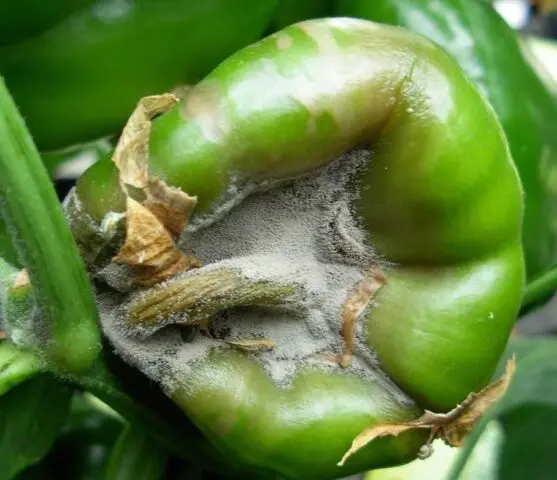
The black leg affects peppers usually at the seedling stage before the appearance of true leaves.
Gray mold
The gray mold fungus infects most vegetable crops, including bell peppers. Differs in high endurance, survives in the soil on the plant remains even in frosty winters. It appears with the onset of warm weather as gray velvety necrotic spots on leaves and stems. Most often occurs at a temperature of about 20 ° C in rainy weather with a lack of sunlight, it affects the culture during flowering and fruiting.

Gray mold develops with a lack of potassium and calcium in the soil
It is possible to treat pepper disease in the early stages with fungicides Amistar, Signum and the like. Spraying is carried out four times with an interval of a week.
White rot
White rot develops mainly on greenhouse-grown peppers. It affects stems, leaves and fruits, manifests itself as watery spots, which quickly become covered with a cottony light coating. Over time, black dots of spores appear on the surface of the latter. White rot can lead to significant yield losses at the fruit ripening stage.
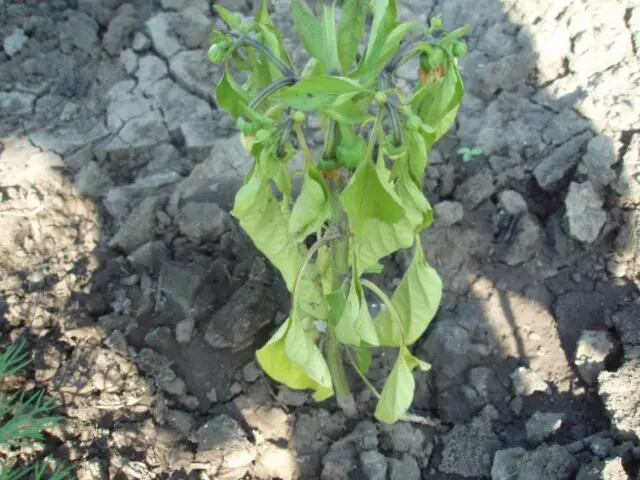
White rot especially often develops at a temperature of about 22 ° C
When symptoms of the disease appear, affected plants must be removed. In autumn, the soil on which the bushes grew is treated with chemicals to destroy the remnants of spores.
Fitoftoroz
A common pepper disease leaves brown spots on the leaves and stems of the plant, which eventually pass to the fruit and harm the crop. The disease often spreads to plantings from other crops or develops on poor soil with micronutrient deficiencies.
To prevent late blight, bushes should be treated with fungicides and home remedies containing manganese and iodine. Potassium-copper fertilizing protects against the development of planting disease. If the plants have already been affected by the fungus, they must be removed from the site and burned.
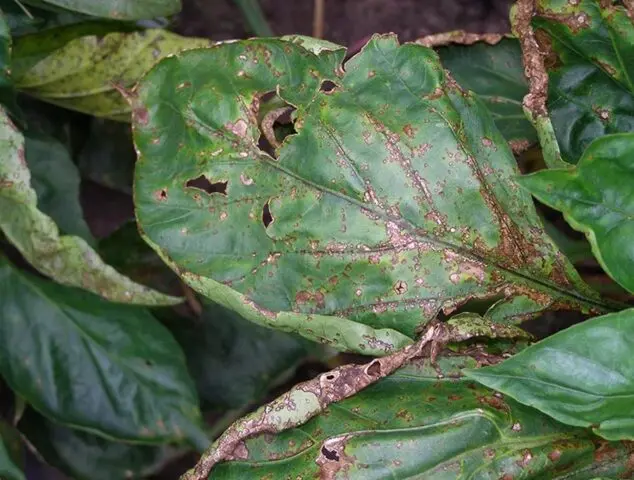
To prevent late blight, peppers are recommended to be planted away from other Solanaceae.
Antraknoz
A fungal disease of sweet pepper on the leaves appears on acidic soils with a lack of phosphorus and potassium and against the background of high air temperature. The plates are covered with brown marks with a brown border, over time, the spots spread along the stems and fruits, merging and deepening. Pepper ceases to receive useful substances in the right amount and quickly fades.
When affected by the disease, it is necessary to remove the affected parts or entire bushes. For prevention and treatment, the culture is sprayed with Bordeaux liquid or copper oxychloride, as well as preparations containing sulfur.
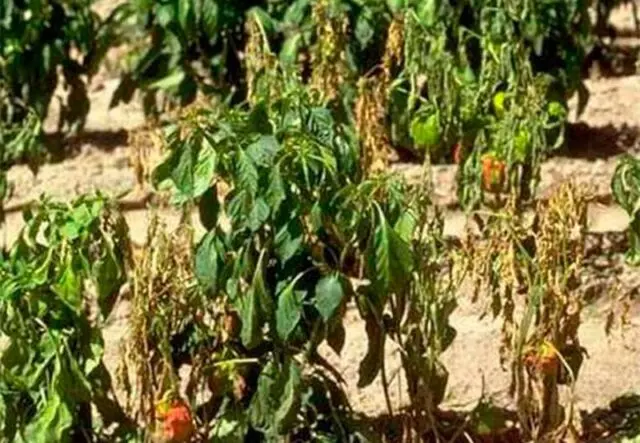
Anthracnose on pepper develops most often in a greenhouse
Fuzarioz
The disease affects the vascular system of the plant and disrupts nutrition processes. The disease can be recognized by blackening of the base of the stem, wilting of the upper leaves and slowing down of the culture. In the absence of a fight against the fungus, the bushes gradually die, necrotic dark pits may appear around the root neck.
With a slight lesion, XOM, Abiga-Peak and Quadris preparations can be used to treat sweet pepper disease. If the plant is seriously damaged, it is worth removing it from the site and spraying the remaining plantings.

With Fusarium, pepper leaves first lose turgor, and then change color and dry out.
Alternaria
Fungal disease develops on pepper usually during the ripening period. It leaves rounded spots with a black velvety coating, the fruits become unusable.
The disease occurs in hot weather with little rain at air temperatures above 25 ° C. Most often, plants with mechanical damage or sunburn suffer from the fungus – pathogenic spores easily penetrate their tissues.
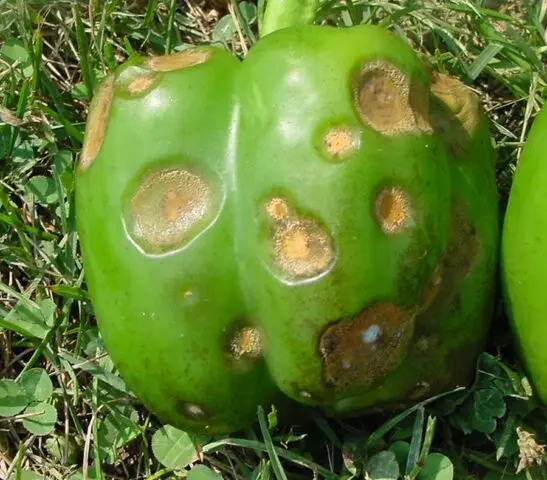
Alternaria progresses on peppers even after harvest
Cladosporiosis
The disease usually appears on greenhouse pepper bushes. You can recognize it by brown spots on the upper side of the leaf plates and a gray coating on the lower surface. If left untreated, it causes rot of the fruit and the stem itself.
In the early stages, the development of cladosporiosis can be stopped by spraying with Fundazol and other fungicides. It is also recommended to reduce the intensity of watering and pay increased attention to the ventilation of the bushes.

Spots with cladosporiosis quickly turn into holes on the leaves
Mučnistaâ rosa
Powdery mildew develops on pepper in hot weather with low humidity. Large whitish spots with a dryish coating appear on the upper side of the plates of the plant; over time, the leaves become deformed and dry out.
The fight against the disease is carried out with copper preparations, heavily affected bushes are eliminated from the beds. To prevent powdery mildew, attention should be paid to regular watering and irrigation.
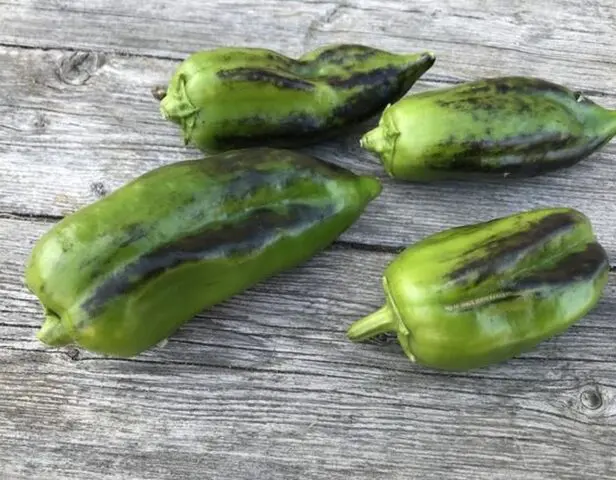
Powdery mildew reduces the yield of pepper bushes
Verticillary wilting
A disease of fungal origin appears on peppers shortly before fruit ripening or directly at harvest. The lower leaves of the plant turn yellow and lose elasticity, yellow, orange or brownish spots appear between the veins or along the edges. Over time, the plates fall off, and the pepper dies completely.
The fungus develops most actively on light soils with a low calcium content at a soil temperature of about 21 ° C. For prevention, it is necessary to feed the plants with mineral fertilizers in a timely manner and disinfect the land on the site in the autumn. Treatment of bell pepper disease in the early stages is carried out with Fitosporin and Fundazol.
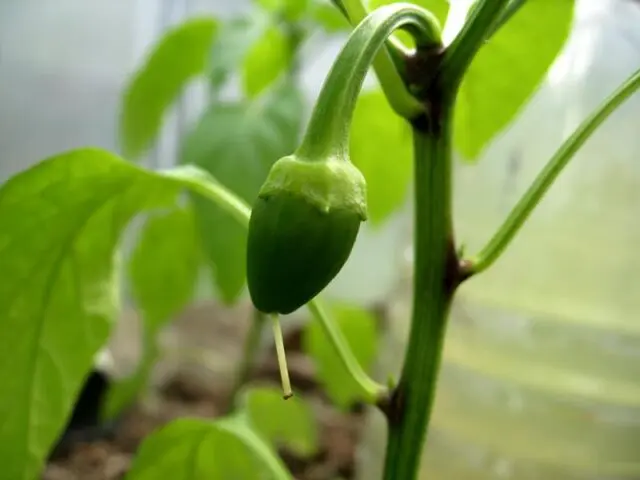
Pepper verticillium often appears against the background of an excess of nitrogen in the soil.
Bacterial diseases of sweet pepper with a description and photo
Bacterial ailments most often harm pepper bushes with mechanical damage to the roots and stems. Pathogenic microorganisms penetrate into plant tissues and lead to their death.
Lightning wilt
A bacterial disease is manifested by mucous white discharge from the stem. Pepper quickly turns yellow and begins to wither, there is a blockage of blood vessels, due to which the access of nutrients to the plant tissues is disturbed.
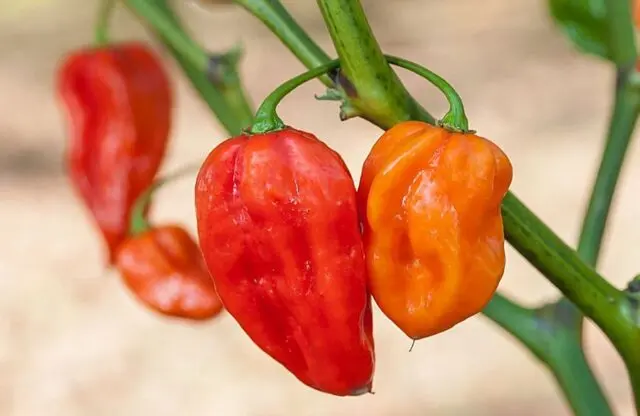
Lightning wilt can kill peppers in 2-3 days
It is difficult to cure lightning-fast wilting, but spraying with copper sulphate helps in the very first stages. To prevent the disease, it is necessary to follow the rules of crop rotation and not plant pepper in one place for more than two years in a row.
Black bacterial spotting
The disease usually manifests itself at a temperature of about 30 ° C with high humidity. Yellowish spots with a dark border form on the leaves of pepper, gradually the marks themselves turn black, and the frame becomes light in color. Convex dots appear on the fruits, which eventually turn into sores with a clear rim.
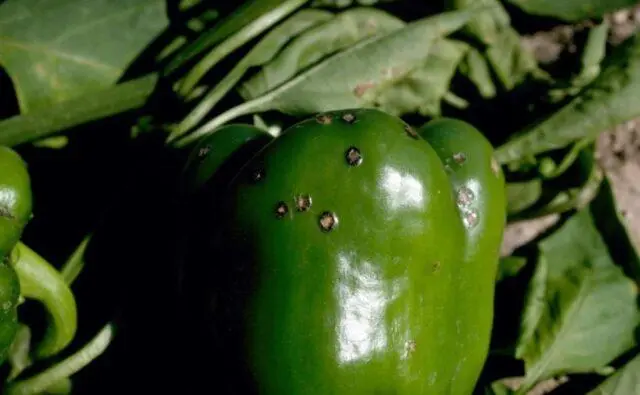
Pepper fruits with black bacterial spot rot from the inside
The disease affects pepper at any stage of vegetation – from the first shoots to harvest. You can cope with the disease in the early stages with Gamair and HOM preparations, it is better to completely destroy heavily affected bushes.
soft rot
Soft rot appears on pepper in wet weather with insufficient ventilation of plantings. The leaves of the plant turn pale, the stem becomes empty from the inside and fades, watery circles appear on the aerial parts, pressed inward.
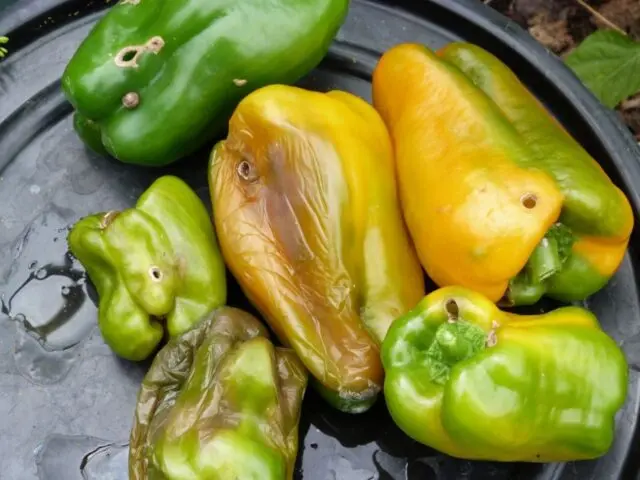
Soft rot can suffer, including pepper fruits already harvested from the beds
To prevent the disease, it is recommended to water the pepper with Fitosporin-M even at the planting stage. Ripe fruits are carefully sorted and stored in a dry place with good ventilation.
Bacterial cancer
Pepper most often suffers from bacterial cancer in rainy and hot weather. You can recognize the disease by depressed spots with a dark core on the fruits and by brown marks with a light center on the leaves.
The fight against bell pepper disease is reduced to the treatment of plantings with copper sulfate twice a day until the symptoms disappear. When sowing, it is recommended to soak the seeds of the culture in a solution of Fitolavin-M 0,2%.
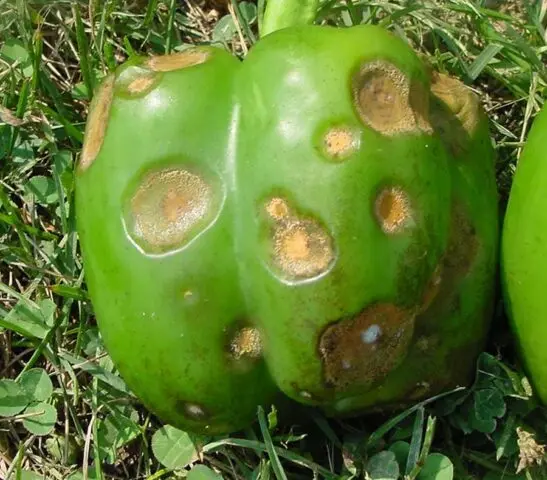
Bacterial cancer affects pepper usually in the southern regions
Viral infections
Viral diseases pose a great danger to pepper. Most of them cannot be treated, therefore, if the corresponding symptoms occur, the bushes simply have to be destroyed.
leaf curl
With the curl virus, pepper does not always die, but its leaves are deformed and twisted, the shoots are shortened, and the fruits are smaller. In some cases, the bushes remain green, in others they turn yellow and fade over time.
The disease passes to the crop from weeds or is carried by pests. To prevent curliness, it is necessary to monitor the cleanliness of the site and eliminate insects in time.

Pepper, when affected by the curl virus, gradually degenerates
Tobacco mosaic
A dangerous disease leaves yellowish patterns on the leaves and leads to a slowdown in the growth of pepper bushes. The fruits of the culture are shrinking, the volume of the crop is falling. Mosaic symptoms are most pronounced in early spring and late fall. The virus spreads through gardening tools or in close proximity to other infected crops.

To prevent mosaic, it is recommended to grow pepper varieties that are resistant to this disease.
There is no cure for pepper leaf disease. But a good prevention of mosaic is the disinfection of seeds in a weak solution of sodium hypochlorite.
Stolbur (phytoplasmosis)
In dry, hot weather, pepper bushes can suffer from stolbur, or phytoplasmosis. The upper leaves of the culture turn yellow and curl, the flowers become sterile and crumble. Rare fruits turn red prematurely. Dried leaf plates often continue to be held on the shoots.
Stolbur cannot be cured, so the pepper has to be destroyed. To prevent the disease, it is useful to treat with Karbofos and Fufanon, since the virus is usually carried by sucking insects.
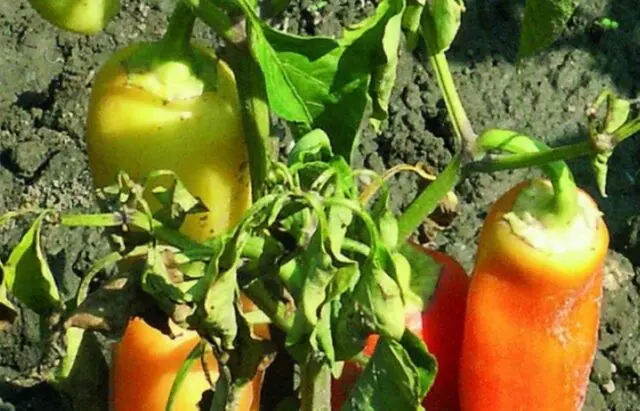
Ripening peppers with stolbur are distinguished by a woody structure
Strick
The viral disease mainly affects the tops of pepper bushes. Dark or light gray strokes appear on ripening fruits, with time the petioles and stems of the culture become covered with stripes. The tissues in the affected areas cork, the pepper bends and breaks. The fruits of the plant become unusable.
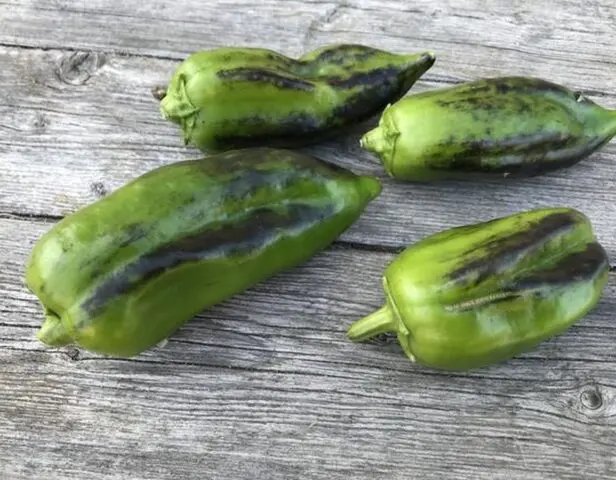
Streak on pepper appears in the middle of summer and quickly spreads through plantings
If symptoms of the virus occur, healthy fruits must be removed from the bushes, and the remaining plantings should be treated with Farmiod’s solution. Before harvesting, spraying is not carried out, since the drug causes burns of vegetables and provokes their decay.
Noncommunicable diseases
Some diseases appear on pepper bushes from a lack of nutrients or due to violations in agricultural technology. In some cases, the symptoms are easy to eliminate, in others it is necessary to put up with the inevitable losses in yield.
fruit cracks
In hot weather and in conditions of a sharp increase in air humidity, cracks may occur on ripening pepper fruits. The phenomenon often leads to rotting of the crop or to the ingress of bacteria into the plants.

Timely feeding with potassium helps prevent cracking of peppers.
Death of shoot tips and ovaries
The phenomenon usually develops a few weeks after planting the peppers. Shedding of the ovaries occurs due to an excess of nitrogen in the soil or against the background of a lack of calcium and boron.
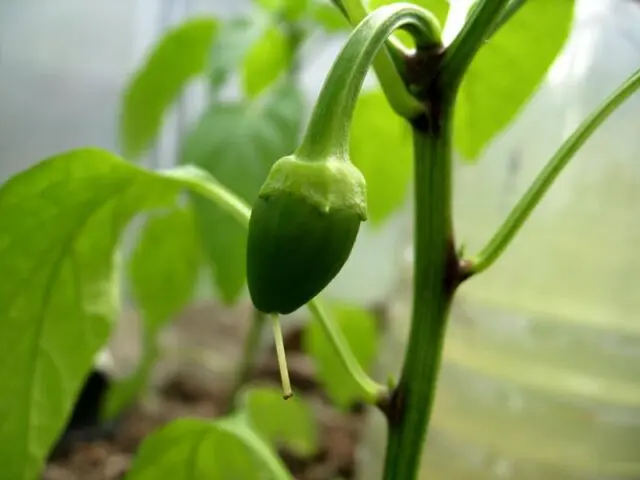
When the ovary dies, it is recommended to reduce watering and carry out urgent feeding of pepper
Sunburn
In dry weather, when grown in an open area, peppers can suffer from bright sun. Yellowish spots appear on the leaves, the stem and fruits begin to dry out.
To prevent burns, the culture in case of excess sun is covered with a light cloth or paper to protect against ultraviolet radiation. The film cannot be used, because the bushes will rot under it.

To avoid sunburn, do not water and spray peppers in the heat of the day.
fruit deformation
In the absence of fungal and viral infections, pepper fruits can become deformed due to excess nitrogen in the soil. In this case, dark green or purple stripes additionally appear on the skin of vegetables.
When growing a crop, it is necessary to control the amount of fertilizing and deoxidize the soil from time to time. Nitrogen is introduced into the soil only in early spring during the period of active development of greenery.
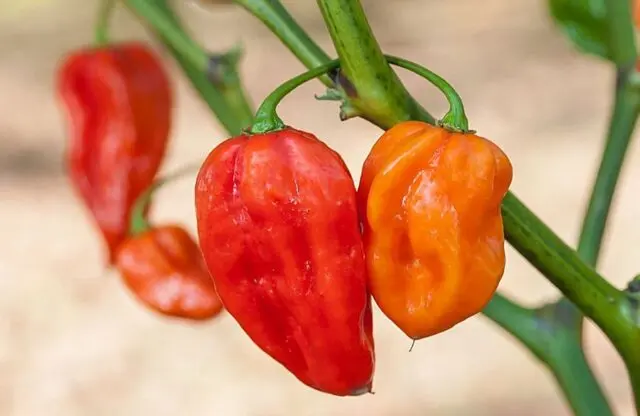
To prevent fruit deformation, pepper is fed with phosphorus and potassium.
Pepper Disease Prevention
Controlling sweet pepper diseases can be quite difficult. Therefore, you need to follow the rules to prevent most ailments:
- observe crop rotation and plant crops in one area for no longer than two years in a row;
- do not place pepper next to other Solanaceae;
- every autumn, carefully clean the area from plant debris and dig 25 cm deep;
- control watering and prevent waterlogging of the soil.
During the growing season, pepper beds should be regularly inspected for diseases and pests. If strange spots and deformations appear on the leaves and ripening fruits, it is necessary to determine the possible cause and immediately process the plantings.
Conclusion
Pepper diseases are not always amenable to successful treatment. To protect the culture from viruses and fungi, you need to focus on preventive measures and observe agricultural practices.









